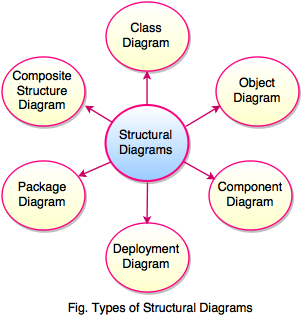
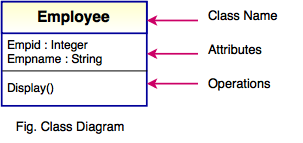
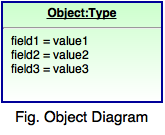
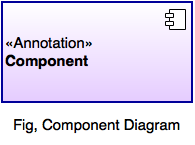
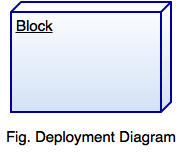
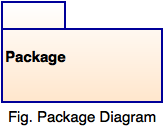
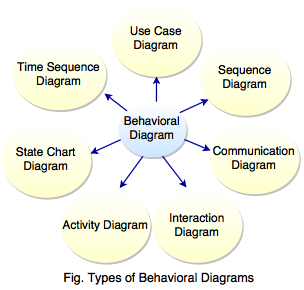
| Components | Description |
|---|---|
 | It describes the interactions that take place between actors and IT systems during the execution of business processes. |
 | It represents the users of system, actors can actually be anything that needs to exchange information with the system. It may be people, computer hardware, other system etc. |
 | It represents a connection between an actor and a use case. It indicates that an actor can carry out a use case. |
 | It is a relationship between two use cases. It specifies how the behavior for the inclusion use case is inserted into the behavior defined for the base use case. |
 | It specifies how the behavior of the extension use case can be inserted into the behavior defined for the base use case. |
 | It represents inheritance relationship between model elements of same type. |
 | It is a relationship between a specification and its implementation. It is used to model stepwise refinement, optimizations, transformations, templates, model synthesis, framework composition etc. |
 | It describes a structure of collaborating elements. |
| Components | Meaning | Description |
|---|---|---|
 | Actor | It represents role played by human users, external hardware or other subjects. |
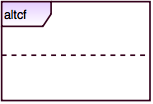 | Alternative Combined Fragment | It defines an expression of interaction fragments. Using combined fragment the user will be able to describe a number of traces in a compact and concise manner. |
 | Call Message / Send Message / Sequence Message | It defines a particular communication between lifelines of an interaction. It represents an invocation of operation of target lifeline. |
 | Concurrent | It represents a session of concurrent method invocation along an activation. It's placed on top of an activation. |
 | Constraint | It represents a condition or restriction expressed in natural language text or in a machine readable language for the purpose of declaring some of the semantics of an element. |
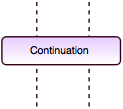 | Continuation | It is a syntactic way to define continuations of different branches of an Alternative Combined Fragment. It represents intermediate points in a flow of control. |
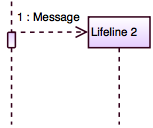 | Create Message | It defines a particular communication between Lifelines of an interaction. It represents instantiation of lifeline. |
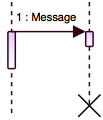 | Destroy Message | It defines a particular communication lifelines of an interaction. It represents the request of destroying the lifecycle of target lifeline. |
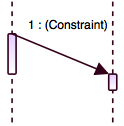 | Duration Constraint | It defines a constraint which refers to a DurationInterval. |
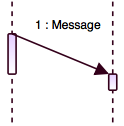 | Duration Message | It defines a particular communication between lifelines of an interaction. It shows the distance between two time instants for a message invocation. |
 | Found Message | It is a message where the receiving event occurrence is known, but there is no sending event occurrence. |
 | Frame | It represents interaction which is a unit of behavior that focuses on the observable exchange of information between ConnectableElements. |
 | Gate | It is a connection point for relating a message outside an interaction fragment with a message inside the interaction fragment. |
 | Lifeline | It represents an individual participant in the interaction. |
 | Lost Message | It is a message where the sending event occurrence is known, but there is no receiving event occurrence. |
 | Note | It gives the ability to attach various remarks to elements. |
 | Return Message | It defines a particular communication between lifelines of an interaction. |
 | Recursive Message | It is a kind of message that represents the invocation of message of the same lifeline and it's target points to an activation on top of the activation where the message was invoked from. |
 | Reentrant Message | It points to an activation on top of another activation. |
 | Self Message | It represents the invocation of message of the same lifeline. |
 | Time Constraint | It defines a constraint which refers to a time interval. |
| Components | Meaning | Description |
|---|---|---|
 | Actor | It represents role played by human users, external hardware or other subjects. |
 | Lifeline | It represents an individual participant in the interaction. |
 | Message / Send Message / Sequence Message / Call Message | It defines a particular communication between lifelines of an interaction. |
 | Return Message | It represents the pass of information back to the caller of a corresponded former message. |
 | Link | It is a tuple with one value for each end of the association, where each value is an instance of the type of the end. |
 | Note | It gives the ability to attach various remarks to elements. |
 | Frame | It represents interaction which is a unit of behavior that focuses on the observable exchange of information between ConnectableElements. |
| Components | Meaning | Description |
|---|---|---|
 | Choice | It realizes a dynamic conditional branch and allows splitting of transitions into multiple outgoing paths. |
 | Deep History | It represents the most recent active configuration of the composite state that directly contains the pseudostate. |
 | Shallow History | It represents the most recent active substate of its containing state. |
 | Entry Point | It represents an entry point of a state machine. |
 | Exit Point | It represents an exit point of a state machine. |
 | Fork and Join | Fork serve to split an incoming transition into two or more transitions terminating on orthogonal target vertices. Join serves to merge several transitions emanating from source vertices in different orthogonal regions. |
 | Final State | It specifies that the enclosing region is completed. |
 | Initial Pseudo State | It represents a default vertex that is source for a single transition to the default state of a composite state. |
 | State | It is a situation during which some invariant condition holds. |
 | Submachine State | It specifies the insertion of the specification of a submachine state machine. |
 | Terminate | It represents the execution of the state machine is terminated. |
 | Transition | It represents a direct relationship between a source vertex and a target vertex. |
| Components | Meaning | Description |
|---|---|---|
 | Activity | It specifies the coordination of executions of subordinate behaviors using a control and data flow model. |
 | Activity Parameter Node | It is an object node at the beginning and end of flows which accept inputs to an activity and provide outputs from the activity, through the activity parameters. |
 | Action | It represents a single step within an activity. |
 | Accept Event Action | It is an action that waits for the occurrence of an event meeting specified condition. |
 | Activity Final Node | It stops all flows in the activity. |
 | Decision Node | It accepts tokens on an incoming edge and presents them to multiple outgoing edges. |
 | Exception Handler | It is an element which specifies a body to execute in case the specified exception occurs during the execution of the protected node. |
 | Control Flow | It is an edge that starts an activity node after the previous one is finished. |
| Components | Meaning | Description |
|---|---|---|
 | Activity Final Node | It stops all flows in the activity. |
 | Control Flow | It is an edge that starts an activity node after the previous one is finished. |
 | Constraint | It represents a condition or restriction expressed in natural language text or in a machine readable language for the purpose of declaring some of the semantics of an element. |
 | Decision Node | It accepts tokens on an incoming edge and presents them to multiple outgoing edges. |
 | Fork and Join | Fork serve to split an incoming transition into two or more transitions terminating on orthogonal target vertices. Join serves to merge several transitions emanating from source vertices in different orthogonal regions. |
 | Initial Node | It represents a default vertex that is source for a single transition to the default state of a composite state. |
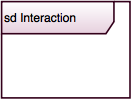 | Interaction | It is a unit of behavior that focuses on the observable exchange of information between ConnctableElements. |
 | Note | It gives the ability to attach various remarks to elements. |
| Components | Meaning | Description |
|---|---|---|
 | Constraint | It represents a condition or restriction expressed in natural language text or in a machine readable language for the purpose of declaring some of the semantics of an element. |
 | Note | It gives the ability to attach various remarks to elements. |
 | Frame | It represents interaction which is a unit of behavior that focuses on the observable exchange of information between ConnectableElements. |